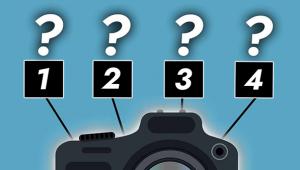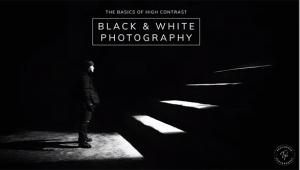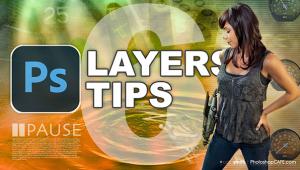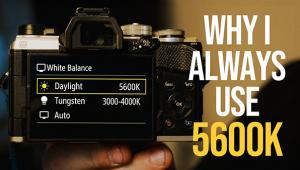The Samsung SyncMaster 244T And 214T LCD Displays; Sometimes Bigger Is Better Page 2
The Samsung SyncMaster 244T LCD Display In Use
With the computer turned off I connected the SyncMaster 244T and plugged in
the power cord and booted up the computer. I immediately found that the default
monitor profile had been switched to the Samsung profile provided on connection,
so was able to go straight into launching Photoshop CS2. I opened my composite
image print test file to get an idea of how the Samsung display was reproducing
a typical range of photographic values. At the default setting, as expected,
the display's high brightness and contrast was noticeably washing out
detail in the photo image's highlights. So, being logical I thought, I
pressed the button controls on the display and began lowering the brightness
until sufficient detail in the highlights was visible on screen. But then, looking
at the shadows, the tones were merged together and too dark to see detail. So,
I hit the display buttons again and lowered the contrast until the shadows opened
up adequately to see detail.
Now I was ready to use my ColorVision Spyder2PRO to calibrate and profile the
monitor to parameters consistent with my Photoshop work space, which is Adobe
RGB (1998), with a color temperature of 6500K and a gamma of 2.2. That went
smoothly, and the result with Photoshop running was a slightly cleaner on-screen
image. To test critical Photoshop functionality I opened a raw 16-bit and unedited
scan file and went about color correcting it. My goal is always to fine-tune
the image so that the on-screen image matches and yields a good print. So I
turned on my Epson R2400 and made a print. Oops, too dark compared to what I
would obtain doing the same thing with a CRT in place of the Samsung SyncMaster
244T.
OK, again trying to be logical, I assumed I was misplacing the midpoint gray
because the display was too bright, so I again lowered brightness. Did that
work? Well, a little, but not enough. So I tried dulling the brightness more.
But this was to no avail, as the display was beginning to look really dull and
muddy. Going back to square one and putting logic aside, I began by lowering
the contrast control on the SyncMaster 244T significantly and the brightness
down just a little, and again for the umpteenth time calibrating and making
a new display profile. Ah! Looks good, and after color correcting yet another
file and making a print, I was almost there. With just one more tweak--lowering
the contrast just a bit more and increasing the SyncMaster brightness setting
a nudge--I again profiled the display. After again doing yet another raw
file and making a print, I was dead on, obtaining a just about ideal print that
matched the display image. In addition, I was then able to make easy and accurate
color correction and image adjustments.
Panorama Pleasures |
|
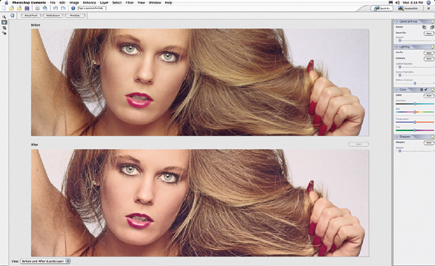 |
|
|
Although this seems like a lot of effort and time just to get a display to
function ideally, it is a one-time thing and very much worth the effort. But
because this involves individual perception, and there are bound to be differences
in digital darkroom environments and perceptions, that may influence the perceived
effect, I won't be more specific about what the final settings adjustments
were; it just might lead you astray.
On To Work
I must note that I'd always experienced all this before with LCDs, and
never satisfactorily resolved it. But now that I had the SyncMaster I was eager
to get on with all the other things I do with my computer to accomplish digital
photography tasks. This includes downloading raw digital camera files and processing
them, scanning slides and film, and color correcting and editing images. During
the time I was testing the SyncMaster 244T I was also in the midst of calibrating
and profiling different papers as part of a beta test of a new color management
system. And the result of all these tasks entirely confirmed that I had gotten
to a point with an LCD that worked in every respect as well as what I have been
used to with CRTs.
But I also learned from the experience with the Samsung SyncMaster 244T that
its rather extreme screen width compared to its height provided a real bonus.
In the past I had tried using two monitors side by side, using one to display
the image I was working on full-screen and the other one for all the tool dialogs
and control windows. For some reason I never found using dual monitors was comfortable
or an entirely advantageous way to work. So the next time I needed a new monitor
I just decided to afford a bigger one. But the Samsung SyncMaster 244T's
extreme-wide format provides plenty of room for a large landscape image or two
quite large portrait images open side by side, and still has room at the sides
for all the dialogs and control windows I needed open to work--the best
of both worlds.
But I was getting too comfortable, as it was about time to pack up the Samsung
and send it back. If my CRTs didn't have at least close to a year's
more good life, I'd have just sent the company a check instead. But I've
already purchased as many of the products I've tested during 2005 that
I can afford.
Evaluation And Recommendation
On the basis of my experience, the 244T, and by extension its slightly smaller
relative, the 214T, have to be among the best LCDs for photographic computing
of any displays offered at a competitive price. Frankly, that doesn't
leave many brands left to try. The Samsung SyncMaster 244T I worked with is
a solid, finely-crafted product that reproduces photographic images with a beautiful
richness of color. It also provides the means to adjust the image attributes
to individual perception that allows for a close match to what you would expect
from the image on screen.
Now that the CRTs photographers and graphic pros relied on for years are gone,
I and a lot of fellow digital photographers I've talked with have been
concerned whether any LCD from the general computer marketplace could do the
job that CRTs handled in the past. I'm happy to report that this newest
Samsung SyncMaster model meets the test in all respects.
Technical Specifications
Samsung SyncMaster 244T (214T)
Type: a-si TFT/PVA
Size: 24" (21.3")
Native Resolution: 1920x1200 pixels (1600x1200 pixels)
Pixel Pitch (mm): 0.270
Brightness (cd/m2): 400 cd/m2 (300 cd/m2)
Response Time: 6 ms [G to G] (8 ms [G to G])
Contrast Ratio: 1000:1 (900:1)
Viewing Angle: 178Þ/178Þ
Interface: Analog/Digital
Input Video Signal: Analog RGB, TMDS Digital Link, S-Video,
CVBS
Input Connectors: 15 Pin D-Sub, DVI-D, S-Video, CVSB, Component
Power Consumption: 100w [Max] (65w)
Stand Type: Four-way adjustable [pivot, tilt, swivel]
Dimensions: 22.9x19.9x10" (18.5x18.4x9.0")
For more information, contact Samsung Electronics America, Consumer Electronics,
105 Challenger Rd., Ridgefield Park, NJ 07660; (800) 726-7864; www.samsung.com/products/monitor/index.asp.
- Log in or register to post comments
















